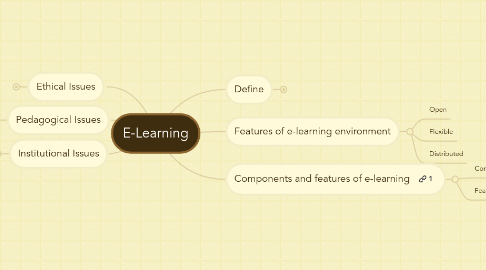
1. Institutional Issues
1.1. Administrative affairs
1.1.1. Needs Assessment
1.1.2. Readiness Assessment
1.1.2.1. Financial Readiness
1.1.2.2. Infrastructure Readiness
1.1.2.3. Cultural Readiness
1.1.2.4. Content Readiness
1.1.3. Organization and Change
1.1.3.1. Diffusion and Adoption
1.1.3.1.1. Diffusion
1.1.3.1.2. Adoption
1.1.3.1.3. Implementation
1.1.4. Budgeting and Return on Investment
1.1.4.1. ROI= (Benefits - Total Cost)/Total Cost %
1.1.4.2. Consider the following
1.1.4.2.1. Instructor compensation
1.1.4.2.2. Travel and per diem for instructors
1.1.4.2.3. Initial program development
1.1.4.2.4. Equipment and software acquisition
1.1.4.2.5. Delivery
1.1.5. Partnership with Other Institutions
1.1.6. Program and Course Information Catalogue
1.1.6.1. General Information
1.1.6.2. Academic Calendar and Course Schedule
1.1.6.3. Tuition and Fees
1.1.7. Marketing and Recruitment
1.1.7.1. Potential students looking for programs with less dropout
1.1.7.2. testimonials on how well the course and program are designed
1.1.7.3. proper feedback on course resources attract students and prevent dropouts
1.1.8. Admissions
1.1.9. Financial Aid
1.1.10. Registration and Payment
1.1.11. Information Technology Services
1.1.12. Instructional Design and Media Services
1.1.13. Graduation, Transcript and Grades
1.1.13.1. Graduation
1.1.13.1.1. Graduation ceremony
1.1.13.2. Transcripts and Grads
1.1.13.2.1. Just-in-time accessibility to transcripts and grades
1.2. Academic affairs
1.2.1. Accreditation
1.2.2. Policies
1.2.3. Instructional Quality
1.2.4. Faculty and Staff Support
1.2.5. Workload, Class Size, and Compensation
1.2.6. Intellectual Property Rights
1.3. Student services
1.3.1. Pre-Enrollment Services
1.3.2. Orientation
1.3.3. Faculty and Staff Directories
1.3.4. Advising
1.3.5. Services for Students with Disabilities
1.3.6. Counseling
1.3.7. Learning Skills Development
1.3.8. Library Support
1.3.9. Bookstore
1.3.10. Tutorial Services
1.3.11. Mediation and Conflict Resolution
1.3.12. Social Support Network
1.3.13. Student Newsletter
1.3.14. Internship and Employment Services
2. Pedagogical Issues
2.1. Content Analysis
2.1.1. What type of content appropriate to teach online?
2.1.1.1. content best served by personal interaction
2.1.2. some subjects are not good for online
2.1.2.1. complex physical skills
2.1.2.1.1. examples
2.1.2.2. intense behavioral modification
2.1.3. Type of content
2.1.3.1. Dynamic
2.1.3.1.1. timeline
2.1.3.2. Stable
2.2. Audience Analysis
2.2.1. Learners may come from culturally diverse background
2.2.1.1. Internet literate
2.2.2. They may differ how they learn
2.2.3. examples?
2.2.3.1. individuals with disabilities
2.2.3.1.1. consider elearning at increasing rate
2.3. Goal Analysis
2.3.1. a goal is an expression to instructional purpose
2.3.1.1. generally more inclusive and less precise
2.3.1.1.1. familiar with elearning tools
2.3.1.1.2. elearning components
2.3.1.1.3. advantages and disadvantages of elearning
2.3.1.1.4. awareness of elearning
2.3.1.1.5. Implementation of elearning tools
2.3.1.1.6. E-learning assessment
2.3.1.1.7. Managing e-learning
2.3.1.2. do not write a goal for a segment smaller than a lesson
2.3.2. an objective identifies the performance student must meet to reach the goal
2.3.2.1. there can be several units each unit can have one or more lesson
2.3.2.1.1. giving course via Internet
2.3.2.1.2. comparing university services
2.3.2.1.3. managed our own courses
2.3.3. Important to have clear goals and objectives
2.4. Medium Analysis
2.4.1. Selection
2.4.1.1. online
2.4.1.1.1. Flash
2.4.1.1.2. Mp3
2.4.1.1.3. video files
2.4.1.2. offline
2.4.1.2.1. CD
2.4.1.2.2. Video
2.4.1.2.3. Tapes
2.5. Design approach
2.5.1. ill-structured problem
2.5.1.1. example
2.5.1.1.1. figuring out whether or not to trade in you 10-year car
2.5.1.1.2. major selection
2.5.2. well-structured problem
2.5.2.1. example
2.5.2.1.1. solving a quadratic equation
2.5.3. Student-center learning
2.5.4. Program-centered learning
2.6. Instructional Strategies
2.6.1. Presentation
2.6.2. Exhibits
2.6.3. Demonstration
2.6.4. Drill and practice
2.6.5. Tutorials
2.6.6. Storytelling
2.6.7. Games
2.6.8. Simulations
2.6.9. Role-Playing
2.6.10. Discussion
2.6.11. Interaction
2.6.12. Modeling
2.6.13. Facilitation
2.6.14. Collaboration
2.6.15. Debate
2.6.16. Filed Trips
2.6.17. Case studies
2.6.18. Motivation
2.7. Organization
2.8. Blending Strategies
2.8.1. Dimensions of the Blend
2.8.1.1. Blending Offline and Online learning
2.8.1.2. Self-Paced and Live, Collaborative Learning
2.8.1.3. Blending Structured and Unstructured Learning
2.8.1.4. Blending Custom Content with Off-the-Shelf Content
2.8.1.5. Blending Learning, Practice, and Performance Support
2.8.2. Why Blend?
2.8.2.1. Not new concept
2.8.2.1.1. Lectures
2.8.2.1.2. Labs
2.8.2.1.3. Books
2.8.2.1.4. Handouts
2.8.2.2. Learning is not one time event but continuous process
2.8.2.3. Benefit over using any single learning delivery medium
3. Ethical Issues
3.1. Social and Political influence
3.2. Cultural diversity
3.3. Bias
3.4. Geographical diversity
3.5. learner Diversity
3.6. Digital divide
3.7. Etiquette
3.8. Legal issue
4. Define
4.1. On the net
4.2. Our definition
4.2.1. A Curriculum-based transfer of knowledge to students via the Internet
5. Features of e-learning environment
5.1. Open
5.2. Flexible
5.3. Distributed
6. Components and features of e-learning
6.1. Components
6.1.1. Instructional Design
6.1.1.1. Learning and Instructional Theories
6.1.1.2. Instructional Strategies and Techniques
6.1.1.3. ADDIE model
6.1.1.3.1. Analyze - analyze learner characteristics, task to be learned, etc
6.1.1.3.2. Design - develop learning objectives, choose an instructional approach
6.1.1.3.3. Develop - create instructional or training
6.1.1.3.4. Implement - deliver or distribute the instructional materials
6.1.1.3.5. Evaluate - make sure the materials achieved the desired goals
6.1.2. Multimedia Components
6.1.2.1. Text and Graphics
6.1.2.2. Audio Streaming (Real Audio, ... etc)
6.1.2.3. Video Streaming (Quiz Time, WMA, ... etc)
6.1.2.4. Links (Hyperlinks, Hypermedia, 3-D links, imagemaps, ... etc)
6.1.3. Internet Tools
6.1.3.1. Communications Tools
6.1.3.1.1. Asynchronous
6.1.3.1.2. Synchronous
6.1.3.2. Remote Access Tools
6.1.3.2.1. Telnet
6.1.3.2.2. gopher
6.1.3.2.3. ftp
6.1.3.3. Internet Navigation Tools
6.1.3.3.1. Text based browser
6.1.3.3.2. VRML
6.1.3.3.3. Graphical browser
6.1.3.4. Search Tools
6.1.3.4.1. Search Engines
6.1.3.5. Online agents
6.1.4. Computers and Storage Devices
6.1.4.1. Computers
6.1.4.1.1. Desktop
6.1.4.1.2. Laptops
6.1.4.1.3. PDA
6.1.4.1.4. UMPC
6.1.4.2. Storage Devices
6.1.4.2.1. CD
6.1.4.2.2. Flash Memory
6.1.4.2.3. U3
6.1.5. Connections and Service Providers
6.1.5.1. Modems
6.1.5.2. Wired
6.1.5.2.1. Dial in
6.1.5.2.2. dedicated
6.1.5.3. Wireless
6.1.5.3.1. wireless LAN
6.1.5.3.2. WAN
6.1.5.3.3. PAN
6.1.5.3.4. WiFi
6.1.5.3.5. WiMax
6.1.6. Authoring Programs and Standards
6.1.6.1. Scripting Languages
6.1.6.2. LMS
6.1.6.3. HTML
6.1.6.4. SCORM
6.1.7. Server and Related Application
6.1.7.1. HTTPS
6.1.7.2. ASP
6.1.7.3. WAP
6.1.7.4. Configuration
6.2. Features
6.2.1. Interactive
6.2.2. OpenSystem
6.2.3. Multimedial
6.2.4. Online search
6.2.5. Device-distance-time independent
6.2.6. Globally accessible
6.2.7. Electronic publishing
6.2.8. Uniformity world-wide
6.2.9. Online resources
6.2.10. distributed
6.2.11. Cross-cultural
6.2.12. Interaction
6.2.13. Multiple expertise
6.2.14. Industry supported
6.2.15. Learner-controlled
6.2.16. Convenient
6.2.17. Self Contained
6.2.18. Ease of use
6.2.19. Authentic
6.2.20. Friendly
6.2.21. Cost effective
6.2.22. Collaborative
6.2.23. Virtual cultures
6.2.24. many more....

